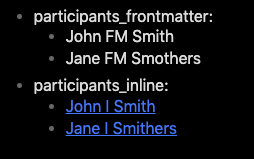Things I have tried
I’m using my vault to manage information on contacts and meetings.
When I create meeting notes, I include an inline data field to list participants, and link to their respective contact notes. For any meeting, there can be several contacts listed.
Participants::
Then, in the contact note, I would like to use dataview to return a list of all the meetings in which that contact is listed as a participant. This is where I am having trouble. I have found that if I include “participants” in the YAML, I am able to retrieve the list of meetings using the following:
list
WHERE type = "meeting"
WHERE icontains(participants, "NAME")
SORT date desc
However, this same query will not work with the participants listed in the inline data field.
I’d prefer not to have to put the participant names in the YAML because I like having the link directly to the contact notes, and don’t want to have to write all the names twice.
What I’m trying to do
I’d appreciate any advice on how to format the inline data field and/or dataview query so that I can retrieve names from a listed array. I’m also open to suggestions on how to set this up in a better way that what I’ve have so far. Thanks.


